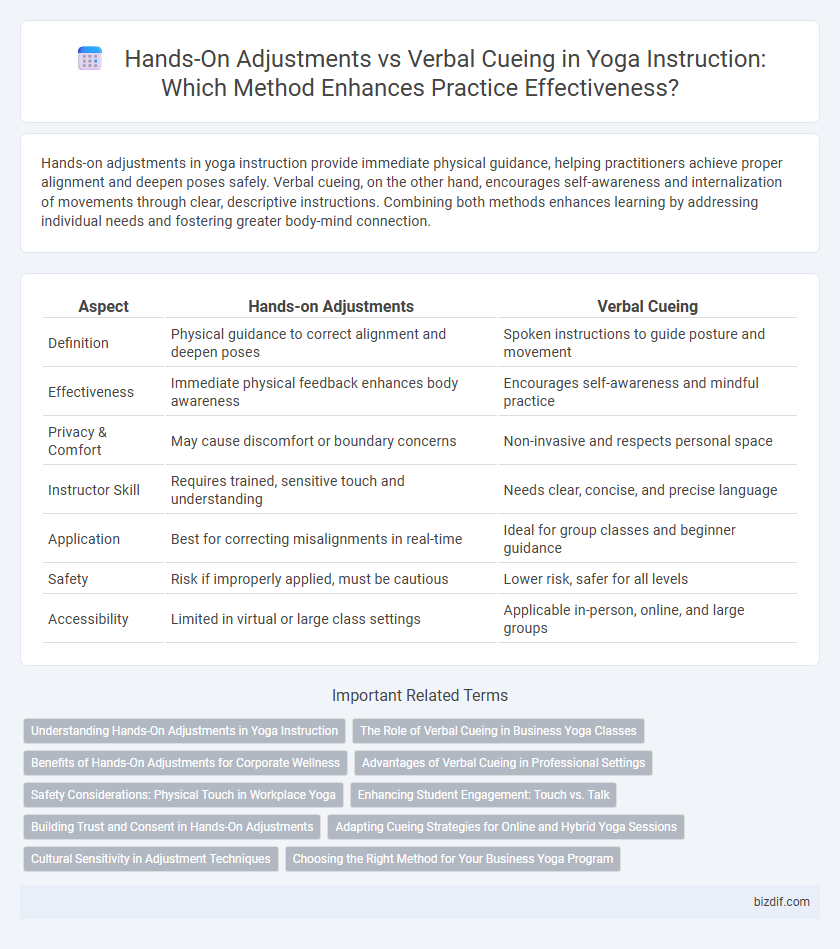Hands-on adjustments in yoga instruction provide immediate physical guidance, helping practitioners achieve proper alignment and deepen poses safely. Verbal cueing, on the other hand, encourages self-awareness and internalization of movements through clear, descriptive instructions. Combining both methods enhances learning by addressing individual needs and fostering greater body-mind connection.
Table of Comparison
| Aspect | Hands-on Adjustments | Verbal Cueing |
|---|---|---|
| Definition | Physical guidance to correct alignment and deepen poses | Spoken instructions to guide posture and movement |
| Effectiveness | Immediate physical feedback enhances body awareness | Encourages self-awareness and mindful practice |
| Privacy & Comfort | May cause discomfort or boundary concerns | Non-invasive and respects personal space |
| Instructor Skill | Requires trained, sensitive touch and understanding | Needs clear, concise, and precise language |
| Application | Best for correcting misalignments in real-time | Ideal for group classes and beginner guidance |
| Safety | Risk if improperly applied, must be cautious | Lower risk, safer for all levels |
| Accessibility | Limited in virtual or large class settings | Applicable in-person, online, and large groups |
Understanding Hands-On Adjustments in Yoga Instruction
Hands-on adjustments in yoga instruction provide tactile guidance that helps students align their bodies safely and deepen postures while fostering a personal connection between teacher and practitioner. Unlike verbal cueing, which relies on descriptive language, physical adjustments offer immediate biomechanical feedback that can clarify complex poses and correct subtle misalignments. Effective hands-on adjustments enhance proprioception and body awareness, making them a valuable complement to verbal instructions in cultivating mindful and precise yoga practice.
The Role of Verbal Cueing in Business Yoga Classes
Verbal cueing plays a crucial role in business yoga classes by enhancing students' understanding of alignment and breath control without physical contact, ensuring a comfortable and inclusive environment. Clear, precise language helps participants of varying skill levels follow sequences effectively while minimizing the risk of injury. This approach supports scalability in corporate settings, allowing instructors to maintain engagement and motivation through tailored, accessible instruction.
Benefits of Hands-On Adjustments for Corporate Wellness
Hands-on adjustments in yoga instruction enhance body alignment, promoting injury prevention and deeper muscle engagement, which is crucial for corporate wellness programs aiming to reduce workplace stress and improve employee physical health. This tactile feedback facilitates personalized corrections that verbal cues alone may not achieve, accelerating progress and boosting confidence for busy professionals. Integrating hands-on adjustments fosters a mindful connection between movement and breath, leading to increased focus and overall well-being in corporate settings.
Advantages of Verbal Cueing in Professional Settings
Verbal cueing in yoga instruction enhances clarity and safety, allowing practitioners to internalize poses without physical interference. It fosters independence and mindfulness, encouraging students to listen to their bodies and adapt poses accordingly. Verbal cues also maintain personal boundaries and hygiene, which is essential in professional or group settings.
Safety Considerations: Physical Touch in Workplace Yoga
Hands-on adjustments in workplace yoga require careful assessment to ensure participant comfort and consent, minimizing risk of injury or discomfort. Verbal cueing offers a safer alternative by guiding alignment and movement without physical contact, reducing liability and respecting personal boundaries. Instructors should prioritize clear communication and obtain explicit permission before any physical adjustments to maintain a safe and respectful practice environment.
Enhancing Student Engagement: Touch vs. Talk
Hands-on adjustments create immediate, tactile feedback that deepens body awareness and alignment in yoga students, fostering a more immersive learning experience. Verbal cueing complements this by guiding mental focus and breath control, enhancing overall engagement through clear, descriptive instructions. Combining touch with talk addresses diverse learning styles, promoting a holistic connection between mind and body during practice.
Building Trust and Consent in Hands-On Adjustments
Building trust in hands-on adjustments during yoga sessions requires clear communication and obtaining explicit consent before physical contact. Verbal cueing establishes a foundation of respect and safety, ensuring practitioners feel empowered and comfortable throughout their practice. Prioritizing consent fosters a positive teacher-student relationship, enhancing the effectiveness of both hands-on guidance and verbal instructions.
Adapting Cueing Strategies for Online and Hybrid Yoga Sessions
Hands-on adjustments enhance alignment and provide personalized support, but online and hybrid yoga sessions often require clear, precise verbal cueing to compensate for the lack of physical presence. Effective adaptation involves using detailed imagery and step-by-step instructions to convey posture nuances, ensuring students maintain safety and form across virtual platforms. Incorporating visual aids and encouraging students to offer feedback enables instructors to tailor cues dynamically in remote environments.
Cultural Sensitivity in Adjustment Techniques
Hands-on adjustments in yoga require acute cultural sensitivity to respect personal boundaries and diverse comfort levels, especially in communities where physical contact may be less accepted. Verbal cueing offers an inclusive alternative, allowing instructors to guide alignment and deepen practice without infringing on cultural norms. Balancing these techniques ensures an effective, respectful yoga experience that honors individual preferences and cultural backgrounds.
Choosing the Right Method for Your Business Yoga Program
Hands-on adjustments provide precise alignment corrections and foster trust in personalized yoga sessions, enhancing student retention and satisfaction. Verbal cueing promotes mindfulness and independence by encouraging practitioners to internalize body awareness, suitable for group classes or hybrid formats. Balancing both methods optimizes teaching effectiveness and aligns with diverse client preferences, boosting the overall success of your business yoga program.
Hands-on adjustments vs verbal cueing Infographic

 bizdif.com
bizdif.com